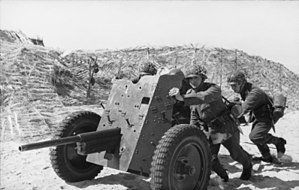3.7 cm Pak 36
| 3.7 cm Pak 36 | |
|---|---|

3.7 cm Pak 36
|
|
| Type | Anti-tank gun |
| Place of origin | Nazi Germany |
| Service history | |
| Used by |
|
| Wars |
Second Sino-Japanese War Spanish Civil War World War II |
| Production history | |
| Designer | Rheinmetall |
| Manufacturer | Rheinmetall |
| Unit cost | $2,579 |
| Specifications | |
| Weight | Travel: 450 kg (990 lb) Combat: 327 kg (721 lb) |
| Barrel length | 1.66 m (5 ft 5 in) L/45 |
| Width | 1.65 m (5 ft 5 in) |
| Height | 1.17 m (3 ft 10 in) |
| Crew | 2 |
|
|
|
| Shell | 37 × 249 mm R |
| Caliber | 37 mm (1.45 in) |
| Elevation | -5° to +25° |
| Traverse | 30° right and left |
| Rate of fire | 13 rpm |
| Muzzle velocity | 762 m/s (2,500 ft/s) |
| Effective firing range | 300 m (328 yds) |
| Maximum firing range | 5,484 m (5,997 yds) |
The Pak 36 (Panzerabwehrkanone 36) was a 3.7 cm calibre German anti-tank gun used during the Second World War. It was the main anti-tank weapon of Wehrmacht infantry units until mid-1941. It was followed in this role by the 5 cm Pak 38 anti-tank gun.
Design of a horse-drawn, 3.7 cm anti-tank gun (designated 3.7 cm Pak L/45) by Rheinmetall commenced in 1924 and the first guns were issued in 1928. By the early 1930s, it was apparent that horse-drawn artillery was obsolescent, and the gun was modified for motorized transport by substituting magnesium-alloy wheels and pneumatic tyres for the original spoked wooden wheels. Re-designated the 3.7 cm Pak 35/36, it began to replace the 3.7 cm Pak L/45 in 1934 and first appeared in combat in 1936 during the Spanish Civil War. It formed the basis for many other nations' anti-tank guns during the first years of World War II. The KwK 36 L/45 was the same gun, but used as the main armament on several tanks, most notably the early models of the Panzer III. The Soviets used the Pak 36 carriage design for their 45 mm M1937 AT gun.
During the May 1940 Western Campaign, the Pak 36, being a relatively small-calibre weapon, was found to be inadequate against heavy Allied tanks like the British Mk II Matilda and the French Char B1 and Somua S35. Still, the gun was effective against the most common light tanks of the era, such as the French R35, whereas the Char Bs and Matildas represented but a small fraction of the total number of armoured vehicles during the Battle of France.
In June 1941, Soviet tank forces consisted of 10,661 T-26, 2,987 T-37/T-38/T-40/T-50s, 59 T-35, 442 T-28, 7,659 BT, 957 T-34, and 530 KVs for a combined total of approximately 23,295 tanks. Thus, during the initial phases of Operation Barbarossa, the Pak 36 could still penetrate the armour of the majority of Soviet AFVs at ranges up to 1000 m from the front, with the notable exception of the T-28s and T-35s, which it could penetrate only at under 100 m; the Pak 36 could not penetrate the relatively thick armour of the T-34s and KV-1s. By late 1941, the widespread introduction of the T-34 on the Eastern Front made the Pak 36 obsolete, considering its miserable performance against it. This led to the Pak 36 being nicknamed Heeresanklopfgerät (literally "army door-knocking device") by German anti-tank crews for its inability to affect the T-34 aside from notifying its presence by futilely bouncing rounds off its armour, regardless of the angle or distance.
...
Wikipedia
